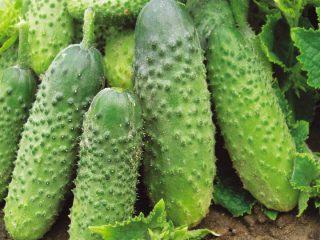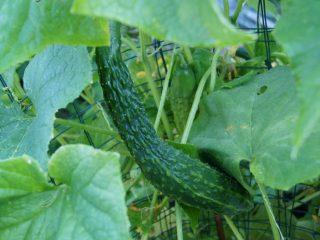Content
Some gardeners are still confused about the varieties and hybrids of cucumbers. To choose the optimal varieties for certain conditions, you need to know about their characteristics. Thus, cucumbers differ in the size and shape of the fruit, taste and color, height of the bush and the presence of side shoots, yield and resistance to diseases or low temperatures. All this is very important, but you need to start choosing a suitable variety of cucumbers with the type of pollination.
Parthenocarpic and bee-pollinated: who is who
As you know, in order for a flower to become a fruit, it must be pollinated. To do this, pollen from the male flower is transferred to the female one. Only female pollinated inflorescences turn into cucumbers. Pollination is most often carried out by insects (bees, bumblebees and even flies); in addition, wind, rain or people can help transfer pollen.
Cucumber varieties and hybrids that require pollination to form an ovary are called bee-pollinated (it does not matter who will actually do the pollination - a bee, the wind or a person). Bee-pollinated cucumbers should be planted where insects can reach them - in open areas or in large, ventilated greenhouses.
Without proper pollination, female flowers become barren flowers, and excess male inflorescences “suck” nutrients and moisture from the entire bush.
Parthenocarpic cucumbers often confused with self-pollinating, but this is incorrect. In fact, parthenocarpic varieties do not need pollination at all. These hybrids have been selected specifically for indoor greenhouses and areas where bees do not fly. All the flowers on the parthenocarpic bush are female; there are no male inflorescences at all. The female flower is considered to be initially pollinated (fertilized); it itself can produce a cucumber.
This structure of parthenocarpic varieties reduces the care of plants; the gardener does not have to monitor the balance of male and female inflorescences, attract bees to the site and worry about too cloudy weather in which bees do not fly.
All parthenocarpic cucumbers are hybrids; moreover, the fruits of these varieties do not contain seeds; there are simply no seeds inside the cucumber. Therefore, in order to plant the same variety next year, you will have to purchase seeds again; they cannot be collected with your own hands from your own harvest (which is quite possible for bee-pollinated cucumbers).
Who is for bee-pollinated varieties?
It would seem that if everything is so good with parthenocarpic hybrids, why do we need bee-pollinated cucumbers at all, and who continues to select and grow them? But there are some nuances here - these varieties have unique properties that are not inherent in unpollinated hybrids. Among them:
- Unique taste qualities. Almost any bee-pollinated variety Tasty both fresh and salted, pickled, and pickled. This is an excellent quality for home growing, when the owner will use the same cucumbers for different needs.
- High yield. With sufficient pollination and proper care, bee-pollinated hybrid varieties produce the highest yields.
- Environmental friendliness. The same bees will help check the level of environmental friendliness of a particular variety - the insect will not pollinate bushes treated with dangerous pesticides.
- Availability of seeds. Firstly, seeds are free seeding material for the following seasons. And, secondly, (and most importantly), it is the seeds that contain the most beneficial vitamins and microelements that cucumbers are so rich in.
- Bee-pollinated varieties - the best material for breeding. It was from these cucumbers that the best hybrids emerged.
Today, there are a lot of bee-pollinated cucumbers; their demand has hardly decreased after the appearance of parthenocarpic species.
Mid-early "Actor"
“Akter” is a bee-pollinated hybrid that embodies the best qualities of this species. This cucumber has a high yield, which allows you to harvest up to 12 kg per square meter of land.
The fruits of this variety are pimply, with large tubercles, they have excellent taste characteristics and are completely free of bitterness (cucumbers are equally appetizing in a salad or in a jar). The size of the cucumber is average (up to 100 grams), the fruits ripen quickly - on the 40th day after planting.
Green branched bushes are disease-resistant; they can grow both outdoors and indoors.
"Hermes F1"
Hybrid "Hermes F1" is early ripening. This is one of the most productive varieties - over 5 kg of cucumbers are harvested from one meter. Small cucumbers have a regular cylindrical shape with small pimples. Cucumbers taste juicy and crispy and are suitable for universal use.
There are no voids or yellow spots inside the fruit, all cucumbers are even - the variety is excellent for sale. The cucumbers themselves are short - only 7-9 cm, they must be collected every day, otherwise the fruits will overgrow and become deformed. Medium-sized bushes with green leaves. The Hermes F1 hybrid is planted only in the ground; this cucumber is not suitable for closed greenhouses.
Features of parthenocarpic cucumbers
Parthenocarpic varieties are an easier way to get about the same yield. The bushes have only female inflorescences, they do not need bees, hybrids are characterized by increased resistance to diseases and temperature changes. Why parthenocarpic cucumbers are loved:
- Easier care.
- Versatility - you can plant cucumbers in the ground, in a closed greenhouse, or on a balcony.
- Less “capriciousness” of varieties in relation to the shade. Parthenocarpic cucumbers do not need to be thinned out too much; they are less susceptible to disease and rot due to poor ventilation and low light.
- No need for bees.
- There is no need to replant seeds from male plants. All seeds are only female, they are completely self-sufficient.
- The yield is equal to bee-pollinated varieties, there are many hybrids that produce up to 20-21 kg per square meter.
- Good taste characteristics and lack of bitterness. Selection allows us to eliminate the substance that gives cucumbers a bitter taste. Parthenocarpic varieties can be eaten fresh and canned.
The versatility of parthenocarpic varieties puts them on a par with bee-pollinated ones. When growing this crop, do not forget that unpollinated cucumbers do not have seeds. The owner will not be able to independently breed new varieties and save on seeds.
Hybrid "Abbad"
The mid-season parthenocarpic cucumber “Abbad” does not need bees, the plant does not need pollination. The yield of the variety is high - up to 11.5 kgm², and the taste characteristics of the fruits are practically no different from bee-pollinated cucumbers, however, this hybrid is more suitable for salads than for pickling.
Cucumbers are long (up to 16 cm) and smooth, bright green in color and cylindrical in shape. When the soil warms up, they can be planted both indoors and outdoors. They are planted from March to July, and harvested until October.
Universal "Augustine"
Proof that parthenocarpic varieties are in no way inferior to bee-pollinated ones can be the hybrid “Augustine”. This is an early ripening cucumber, ripening in 36-38 days.
Cucumbers are quite large - up to 16 cm and 110 g, suitable for both canning and fresh consumption. The tuberous fruits have no bitterness at all. The variety is not afraid of diseases, even such as downy mildew. And the high yield allows you to harvest 265-440 centners of cucumber per hectare of land. Hybrid cucumbers can be planted in both open and closed ground.
Which variety is better
It is impossible to say unequivocally which varieties of cucumbers are better; each owner must take into account the characteristics of his plot, greenhouse, and pay attention to the soil. Well, the main criterion, of course, is the bees.
If cucumbers are to be planted in open ground and there are beehives nearby, then it is better to choose a bee-pollinated variety. Parthenocarpic cucumbers are still more suitable for greenhouses.



















